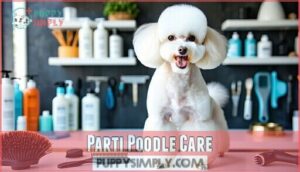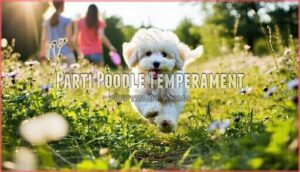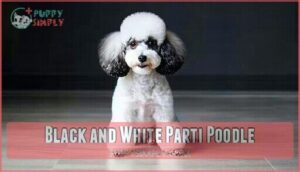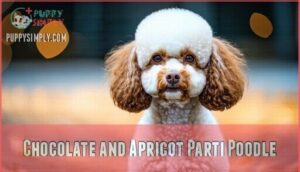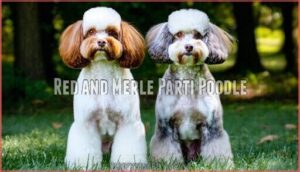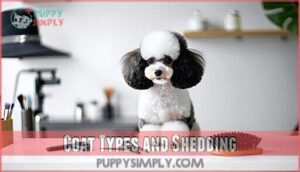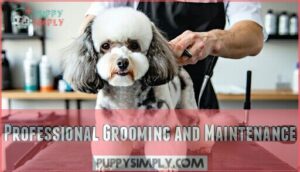This site is supported by our readers. We may earn a commission, at no cost to you, if you purchase through links.
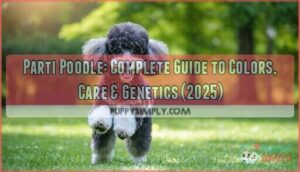 A parti poodle is a poodle with a two-toned coat that’s at least 50% white combined with another solid color like black, brown, or apricot.
A parti poodle is a poodle with a two-toned coat that’s at least 50% white combined with another solid color like black, brown, or apricot.
These striking patterns result from a specific gene mutation that affects pigment distribution. You’ll get the same brilliant, hypoallergenic companion as any poodle, just with eye-catching markings that make heads turn at the dog park.
Once considered "undesirable" by traditional breeders, parti poodles have exploded in popularity as pet owners embrace their unique beauty. They come in all standard poodle sizes and require the same grooming routine and mental stimulation.
Understanding their genetics and care requirements helps guarantee you’re prepared for these stunning companions.
Table Of Contents
- Key Takeaways
- What is Parti Poodle
- Parti Poodle Genetics
- Parti Poodle Care
- Parti Poodle Health
- Parti Poodle Costs
- Parti Poodle Temperament
- Parti Poodle Sizes
- Parti Poodle Colors
- Parti Poodle Grooming
- Finding Parti Poodle
- Frequently Asked Questions (FAQs)
- What does parti Poodle mean?
- Why are parti Poodles rare?
- What is the parti Poodle gene?
- How often do Parti Poodles need to be groomed?
- Are Parti Poodles hypoallergenic?
- What is the best type of exercise for a Parti Poodle?
- Is it safe to have a Parti Poodle around small children?
- What kind of health issues are most common in Parti Poodles?
- Are Parti Poodles hypoallergenic like regular Poodles?
- Can Parti Poodles compete in dog sports?
- Conclusion
Key Takeaways
- You’ll get a striking poodle with at least 50% white coat combined with patches of black, brown, or apricot – each dog’s pattern is completely unique and results from a specific gene mutation that affects pigment distribution.
- You’re looking at the same hypoallergenic, intelligent companion as any standard poodle, but with eye-catching markings that make them stand out at the dog park while requiring identical grooming and exercise needs.
- You can’t show your parti poodle in AKC conformation events due to color restrictions, but they’re fully recognized as purebred and can compete in UKC shows and all other dog sports like agility and obedience.
- You’ll need to budget $1,500-$3,000 for purchase plus ongoing costs for professional grooming every 6-8 weeks, quality food, and regular vet care – their unique coat doesn’t change their standard poodle health requirements or 12-15 year lifespan.
What is Parti Poodle
A Parti Poodle is a poodle with at least 50% white coat and patches of one secondary color like black, brown, or red.
A stunning poodle showcasing nature’s artistry with bold patches dancing across a pristine white canvas.
You’ll recognize these dogs by their unique random patterns that make each one different from solid-colored poodles.
Definition and Appearance
Your parti poodle sports a striking bicolor poodle appearance with at least 50% white as the base.
This coat percentage requirement creates stunning poodle colors featuring black, red, or brown patches scattered across their fluffy frame.
Each spotted poodle displays pattern uniqueness that makes them one-of-a-kind.
While breed standards once favored solid coats, historical depictions show these multicolored beauties graced aristocratic homes for centuries.
Coat Colors and Patterns
Your parti poodle’s coat showcases endless possibilities beyond basic black and white combinations.
Each dog displays unique patterns that make them one-of-a-kind companions.
- Traditional Colors: Black, brown, red, and apricot patches create classic parti poodle appearances
- Modern Patterns: Tuxedo, spotted, and abstract markings offer contemporary styling options
- Rare Markings: Blue brindle and cafe au lait combinations produce extraordinary color fading effects
History and Origins
Contrary to popular belief, Early Poodle Art from the 1400s-1800s shows you multi-colored Poodles weren’t unusual—they were normal.
Parti Poodles were aristocratic favorites centuries before solid colors became the show ring standard.
Rembrandt’s 1631 painting features a striking brown-and-white Parti Poodle.
However, the Solid Color Shift emerged by the mid-20th century when breeders preferred solid coats for shows.
Dedicated Enthusiasts preserved the original Poodle breed despite AKC Show Ban restrictions, leading to today’s Revival Efforts.
| Time Period | Parti Poodle Status |
|---|---|
| 1400s-1800s | Common in Poodle history |
| Mid-1900s | Declined due to show standards |
| Today | Growing popularity revival |
Parti Poodle Genetics
Understanding your Parti Poodle’s genetics helps you predict coat colors and patterns in future generations.
The MITF gene controls these unique markings and requires specific breeding combinations to produce the distinctive white and colored patches you see in these dogs.
MITF Gene and Inheritance
One specific gene controls your Parti Poodle’s unique coat pattern.
The MITF gene causes recessive inheritance, meaning both parents must carry it for parti offspring.
This gene creates random white patches by stopping pigment production in certain areas.
Pattern variations occur naturally, making each dog unique.
Color fading happens over time as MITF expression changes, turning black to blue or red to cream through genetics.
Breeding and Recognition
Breeding Parti Poodles requires understanding both genetics and industry standards.
The AKC recognizes Parti genetics but excludes these dogs from conformation shows due to color restrictions. While purebred, they can’t compete in breed rings. However, the UKC welcomes Parti Poodles in all competitions since 2004.
Here’s what makes Parti Poodle breeding unique:
- Show eligibility limitations – Your beautiful Parti can’t strut their stuff in AKC conformation rings
- Breeding ethics challenges – Some breeders still view parti patterns as "undesirable" despite their purebred status
- Color fading surprises – That stunning black and white puppy might develop blue tones as they mature
- Rare patterns demand – Collectors pay premium prices for unique spotted or tuxedo markings
The Poodle breed community remains divided on parti recognition. Traditional breeders often focus on solid colors for show eligibility, while others embrace these rare patterns. This creates interesting dynamics in breeding programs where surprise parti puppies can appear from solid-colored parents carrying recessive genes.
Genetic Health Issues
Genetic health issues in Parti Poodles often stem from their genetics, including hip dysplasia, epilepsy, and Addison’s disease.
Regular screening tests and early detection are vital for managing dog health.
Responsible breeding helps minimize risks by focusing on healthier lines, and preventative measures like vet check-ups and a balanced lifestyle help keep your Parti Poodle happy and healthy, which is crucial for managing dog health.
Parti Poodle Care
Caring for a Parti Poodle means focusing on their grooming, exercise, and nutritional needs to keep them healthy and happy.
You’ll need to establish a routine that balances regular brushing, quality food, and daily activity.
Diet and Nutrition
Feeding your Parti Poodle right keeps them healthy and happy.
Start with high-quality dog food, balancing kibble vs. raw diets based on their needs.
Puppies need nutrient-rich meals for growth, while seniors benefit from a lighter dog diet.
Consider poodle puppy food for your young Parti Poodle.
Use portion control to prevent overeating.
For allergies, try hypoallergenic options.
Dog treats? Choose ones that support dog health without extra calories.
Grooming and Hygiene
Parti Poodle grooming keeps their unique poodle coat healthy and mat-free.
Regular brushing prevents coat matting, while bathing frequency should be every 4-6 weeks.
Nail trimming avoids discomfort, and teeth cleaning maintains oral health.
Don’t skip ear care, as poodles are prone to infections.
A proper poodle grooming brush helps maintain their coat.
Consistent dog grooming guarantees your Parti Poodle stays clean, comfortable, and looking fabulous!
Exercise and Training
After grooming, it’s time to focus on your Parti Poodle’s exercise needs.
This energetic dog breed thrives on daily dog exercise like walks, fetch, or agility training.
Pair physical activity with mental stimulation, such as puzzle toys or recall training.
Start puppy socialization early to build confidence, and use consistent poodle training techniques for a well-behaved companion, incorporating daily dog exercise.
Parti Poodle Health
Keeping your Parti Poodle healthy means understanding their common health risks and taking steps to prevent issues early.
Regular vet visits, a balanced diet, and proper exercise can help guarantee they live a long and active life.
Common Health Issues
Poodle health has its quirks.
Watch for issues like GDV risk (canine bloat), Addison’s disease, and hip dysplasia. Eye disorders and sebaceous adenitis are also concerns.
Genetics play a role, so regular vet checks are key.
- GDV (canine bloat): Life-threatening stomach twisting
- Addison’s disease: Hormonal imbalance
- Hip dysplasia: Joint problems
- Eye disorders: Vision concerns
- Sebaceous adenitis: Skin inflammation
Lifespan and Mortality
A Parti Poodle’s lifespan depends on size and longevity factors.
Toy Poodles often live 15+ years, while Standards average 12-15.
Genetic predispositions like Addison’s Disease can impact dog health.
Regular dog health tests boost quality of life.
Smaller sizes tend to live longer.
Proper care and preventative measures guarantee a happy, healthy life.
| Size | Average Lifespan | Key Factors |
|---|---|---|
| Toy | 14-16 years | Smaller size, care |
| Miniature | 13-15 years | Balanced health |
| Standard | 12-15 years | Genetics, activity |
Preventative Care
Regular care keeps your Parti Poodle healthy and happy.
Stick to a vaccination schedule, and don’t skip wellness exams for early detection of issues.
Focus on parasite prevention and dental hygiene to avoid bigger problems later.
- Dog health tests: Screen for genetic health risks.
- Dog grooming tips: Prevent matting with regular brushing.
- Dog nutrition: Feed high-quality food for energy.
Parti Poodle Costs
Understanding the costs of a Parti Poodle helps you plan for both the initial purchase and ongoing care.
From the purchase price to grooming and vet expenses, it’s important to budget for their unique needs.
Purchase Price and Expenses
When considering a Parti Poodle, your wallet will feel it.
Puppy prices range from $1,500 to $3,000, influenced by breeder reputation and coat rarity.
Adoption fees are more affordable, between $100 and $500.
Initial costs, including toys and crates, add $100-$300.
Here’s a quick breakdown:
| Expense | Cost Range | Notes |
|---|---|---|
| Puppy Prices | $1,500 – $3,000 | Higher for rare colors |
| Adoption Fees | $100 – $500 | Rescue organizations available |
| Accessories | $100 – $300 | Includes toys, bed, crate |
| Grooming Session | $50 – $100 | Regular maintenance needed |
| Vet Care (Year 1) | $300 – $700 | Essential for health checks |
Ongoing Costs and Budgeting
Owning a Parti Poodle means budgeting for food expenses, grooming costs, regular vet visits, and training fees.
Dog maintenance also includes unforeseen costs like health emergencies. A dog food subscription saves time and effort.
Dog grooming frequency matters too, with trims every 6-8 weeks. Stay prepared for unexpected costs to guarantee your Poodle’s long-term health and happiness.
Value and Investment
When evaluating a Parti Poodle’s value, factors like breeding potential, show prospects, and rarity premium play a big role.
While upfront dog pricing may seem steep, you’re investing in long-term value.
Quality poodle puppies from reputable poodle breeders often retain demand, and compared to investment alternatives, Parti Poodles bring companionship alongside their uniqueness—just plan for ongoing dog care costs responsibly.
Parti Poodle Temperament
Parti Poodles are intelligent, loyal dogs that are easy to train and keen to please. With their active and friendly nature, they make great companions for families and individuals alike.
Intelligence and Trainability
Parti Poodles stand out with their sharp dog intelligence and remarkable trainability.
Their poodle temperament makes them quick learners, mastering commands with ease.
Using positive training methods enhances their problem-solving skills and learning speed.
Thanks to their behavioral traits, consistency and patience are key, leading to excellent command retention and straightforward poodle training, which creates a bond that rewards their keen-to-please attitude, showcasing their keen-to-please nature.
Loyalty and Affection
Known for their affectionate displays, this dog breed’s temperament shines in family settings.
As a loyal family companion, they form strong attachment levels with owners and show remarkable friendliness.
Great with kids, their child interaction feels natural and endearing.
However, high attachment tendencies can lead to separation anxiety, making them thrive best in homes with consistent love and attention.
Energy and Activity Level
This dog breed has lots of energy and thrives with daily exercise needs.
Parti Poodles love mental stimulation and fun playtime activities like fetch or puzzle toys.
Use training games to channel energy bursts and strengthen bonds.
Regular exercise, such as walks or agility courses, keeps them happy and healthy.
Meeting their dog breed energy guarantees a content, well-balanced pet.
Parti Poodle Sizes
Parti Poodles come in four sizes: Toy, Miniature, Standard, and Moyen. Each size has unique weight and height ranges, making it easy to find the perfect fit for your lifestyle.
Toy and Miniature Varieties
Miniature and toy sizes bring charm and versatility to Parti Poodles.
These smaller varieties are perfect for apartments or cozy homes, needing less space but still requiring daily exercise.
Here’s what you’ll love:
- Size Differences: Toy Poodles weigh 4-6 pounds, Miniatures 10-15 pounds.
- Exercise Needs: Both need 30-60 minutes daily.
- Training Adaptations: Smaller size simplifies indoor training.
Standard and Moyen Varieties
Standard and Moyen Poodles are popular Parti Poodle variations, with distinct size differences.
Standard Poodles, the largest, are ideal for active lifestyles due to their exercise needs and bold temperament traits.
Moyens, more compact yet sturdy, fit into smaller homes.
Both sizes require consistent grooming, adding to costs.
Their energetic nature and potential health concerns demand attentive care to thrive.
Size and Weight Considerations
Size standards vary across the Parti Poodle breed.
Understanding your Poodle’s ideal weight helps promote healthy growth. Weight management plays a big role as size genetics influence their lifespan and well-being.
- Toy Poodles: Under 10 inches, 6-9 pounds.
- Miniature Poodles: 10-15 inches, 10-15 pounds.
- Standard Poodles: Over 15 inches, 40-70 pounds.
Parti Poodle Colors
Parti Poodles come in a variety of striking color combinations, with a white base coat and patches of a second color like black, apricot, or red.
These patterns are random and unique, making each dog’s coat truly one of a kind.
Black and White Parti Poodle
When considering black and white Parti Poodles, their striking poodle coat features tuxedo markings or spotted patterns, creating unique looks.
These poodle colors are shaped by breeding challenges and rarity factors, with each one being truly distinctive.
However, color fading may affect their bold markings over time.
Parti Miniature Poodles share this elegant, timeless appeal, adding charm to smaller sizes.
Chocolate and Apricot Parti Poodle
Chocolate and Apricot Parti Poodles showcase stunning color combinations on their bright white coats.
They’re known for their pattern uniqueness, with bold or soft patches. Chocolate hues often lighten due to color fading, while apricot shades can soften over time.
Though striking, these poodles mightn’t meet all breed standards for show eligibility.
- Rich, warm chocolate patterns
- Soft, sunny apricot accents
- Unmatched genetic diversity
Red and Merle Parti Poodle
Red genetics create stunning parti poodle variations when combined with merle patterns.
These rare colors result from specific breeding challenges that make them highly sought after.
You’ll find their visual appeal unmatched in the poodle breed world.
| Feature | Red Parti | Red Merle Parti |
|---|---|---|
| Base Color | Rich red tones | Mottled red-gray mix |
| White Coverage | 50%+ white patches | 30%+ white areas |
| Rarity Level | Uncommon | Extremely rare |
| Breeding Difficulty | Moderate challenge | High complexity |
| Coat Pattern | Bold solid patches | Swirled marbling effect |
The rarity and unique appearance of these poodles are due to the specific breeding challenges and genetic combinations involved.
The breeding difficulty and resulting rarity level contribute to their value and desirability among poodle enthusiasts.
Parti Poodle Grooming
Your Parti Poodle’s dense curly coat requires regular brushing to prevent matting and professional grooming every six to eight weeks.
Proper grooming keeps your dog’s unique color pattern looking its best while maintaining healthy skin and coat condition, which is essential for the overall appearance and well-being of your dog.
Coat Types and Shedding
Your parti poodle’s unique coat patterns don’t change their grooming needs.
These dogs have dense, curly coats that trap loose hair instead of dropping it everywhere.
Their hypoallergenic qualities make them perfect for allergy sufferers, but don’t expect zero maintenance.
- Coat Curliness: Dense, tightly curled hair requires daily brushing
- Shedding Amount: Minimal hair loss compared to other breeds
- Grooming Frequency: Weekly brushing prevents painful matting
- Hypoallergenic Qualities: Low dander production suits sensitive owners
- Seasonal Shedding: Consistent year-round coat maintenance needed
Grooming Techniques and Tools
You’ll need specific grooming essentials for proper parti poodle coat maintenance.
Start with a slicker brush for daily brushing techniques that prevent mats from forming.
Use thinning shears for clipping styles around sensitive areas.
A pin brush works best for fluffing after bathing frequency of every 4-6 weeks.
A quality brush can be found at slicker brush poodle.
Tool selection matters – invest in quality equipment for effective poodle grooming and long-term mat prevention success.
Professional Grooming and Maintenance
While basic grooming keeps your parti poodle looking decent, professional services every six to eight weeks transform their coat completely.
Expert groomers prevent matting through specialized techniques and product selection customized to poodle coats. They’ll recommend specific haircuts that showcase your dog’s parti pattern beautifully.
Cost analysis shows professional maintenance ranges from $75-150 per session, depending on size and styling complexity, with professional services and specialized techniques being key factors in maintaining your poodle’s appearance.
Finding Parti Poodle
You’ll find Parti Poodles through reputable breeders who focus on health testing and proper breeding practices.
Or through rescue organizations that specialize in poodle placement, where you can also expect to find Parti Poodles.
Research potential sources carefully and expect to pay between $700 to $1,500 for a puppy, with prices varying based on size, color patterns, and breeder reputation.
Reputable Breeders and Rescue
Finding the perfect parti poodle starts with choosing ethical breeding practices over quick sales.
Quality breeders provide health guarantees and transparent breeding records, while poodle rescue organizations offer loving homes to dogs needing second chances.
Here are three key considerations when selecting your source:
- Breeder Red Flags – Avoid breeders who won’t show health certificates, refuse home visits, or have multiple litters available simultaneously
- Rescue Benefits – Dog rescue organizations often provide temperament assessments, basic training, and lower adoption fees than purchasing from dog breeders
- Health Guarantees – Reputable sources offer written health documentation and genetic testing results for breeding parents
The adoption process varies substantially between professional breeders and rescue facilities, so research both options thoroughly.
Adoption and Purchase Options
You’ve got two main paths when searching for your parti poodle: rescue organizations or reputable breeders.
Poodle rescue groups often have parti poodles available for $200-500 adoption costs, while ethical breeding typically runs $700-2000.
Watch for breeder red flags like no health testing or refusing home visits.
Poodle adoption through rescue saves lives and money compared to buying poodle puppies from questionable sources.
Registration and Certification
Once you’ve found your parti poodle, you’ll need proper registration papers.
AKC registration allows full documentation despite FCI exclusion from international shows. Most reputable breeders provide pedigree certificates meeting kennel clubs’ breeder standards.
Your parti poodle can compete in UKC conformation events but faces AKC show eligibility restrictions.
Registration guarantees your dog’s lineage verification and breeding rights.
Frequently Asked Questions (FAQs)
What does parti Poodle mean?
A parti Poodle describes a multicolored dog with at least 50% white coat and patches of another color like black, brown, or red.
You’ll notice these unique patterns make each parti Poodle look distinctly different.
Why are parti Poodles rare?
Show breeders historically avoided parti patterns, preferring solid colors for competitions.
You’ll find fewer parti poodles because the AKC excludes them from conformation shows, making breeders focus on solid-colored dogs instead, which is a key reason for the preference.
What is the parti Poodle gene?
The MITF gene creates those adorable white patches you see on parti Poodles.
It’s recessive, so both parents must carry it.
When two carriers mate, you’ll get that stunning multicolored coat pattern that makes these pups so special.
How often do Parti Poodles need to be groomed?
Like knights maintaining their armor, you’ll need to brush your Parti Poodle weekly and schedule professional grooming every six weeks.
Without regular care, their beautiful curly coat becomes severely matted, requiring complete shaving.
Are Parti Poodles hypoallergenic?
Yes, you’ll find these dogs are considered hypoallergenic due to their curly, non-shedding coat that traps dander. However, no dog is 100% allergen-free, so spend time with one first.
What is the best type of exercise for a Parti Poodle?
Walking, running, swimming – these activities challenge your Poodle’s body and mind equally.
You’ll want structured exercise like agility training or fetch sessions lasting at least one hour daily to keep them happy and healthy.
Is it safe to have a Parti Poodle around small children?
Parti Poodles make excellent family companions around small children when properly socialized.
You’ll need to supervise interactions initially and teach kids gentle handling.
Their intelligent, friendly nature typically creates wonderful bonds with youngsters.
What kind of health issues are most common in Parti Poodles?
Health doesn’t discriminate by coat color—your furry friend faces the same risks as any Poodle.
You’ll encounter hip dysplasia, epilepsy, bloat, eye disorders, Addison’s disease, hypothyroidism, and sebaceous adenitis most commonly.
Are Parti Poodles hypoallergenic like regular Poodles?
Like their solid-colored cousins, Parti Poodles are indeed hypoallergenic. You’ll find they produce minimal dander and don’t shed much, making them excellent companions if you’re dealing with allergies or sensitivities.
Can Parti Poodles compete in dog sports?
Your Parti Poodle can excel in virtually every dog sport imaginable.
They’re allowed in AKC obedience, agility, rally, and tracking events.
Their intelligence and athleticism make them natural competitors who’ll shine in any arena.
Conclusion
Beyond their unconventional coat patterns, parti poodles represent exceptional canine companions that blend intelligence with striking aesthetics.
You’ll discover these uniquely marked dogs require standard poodle care while offering the same hypoallergenic benefits and trainability.
Whether you choose a toy or standard parti poodle, proper nutrition, regular grooming, and mental stimulation promote maximal health.
Their distinctive genetics don’t compromise their wonderful temperament or longevity.
A parti poodle brings both beauty and brains to your family dynamic.


